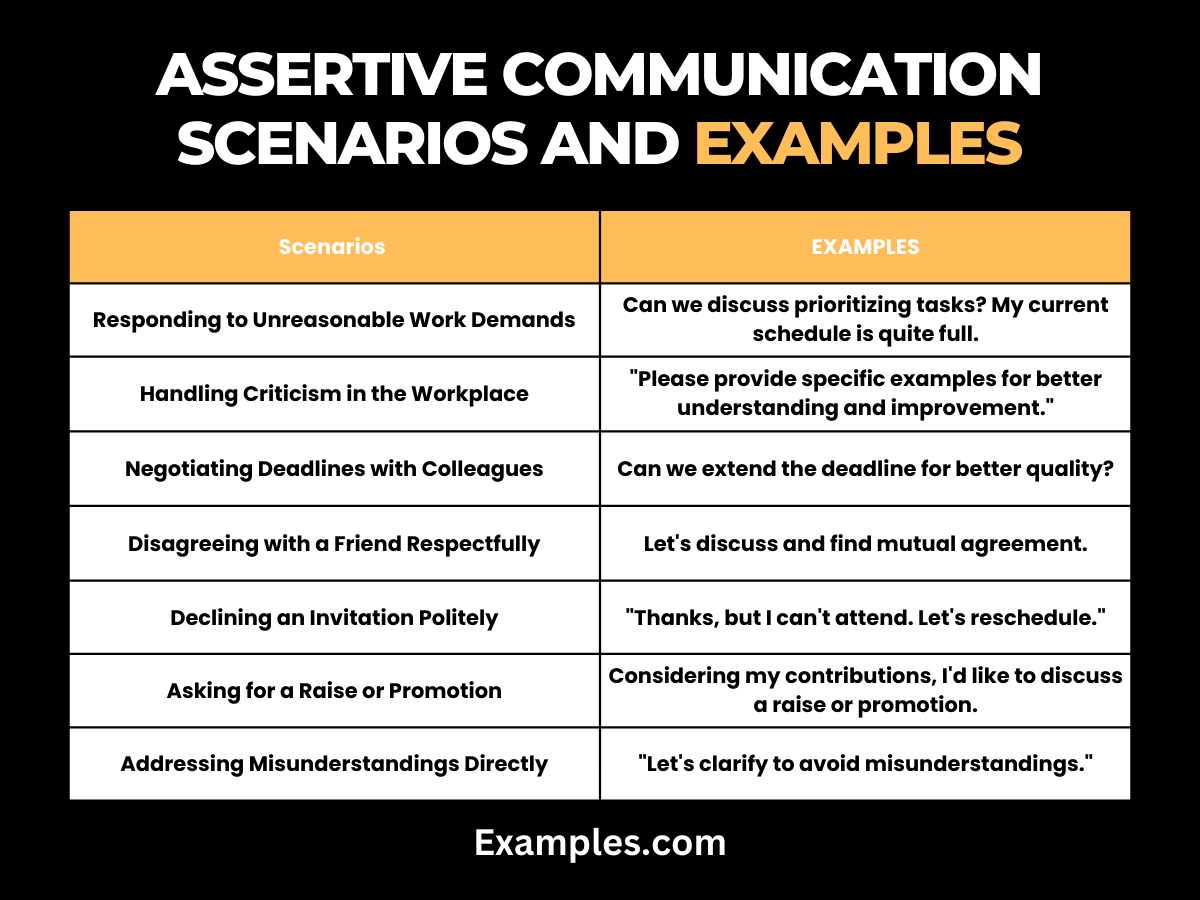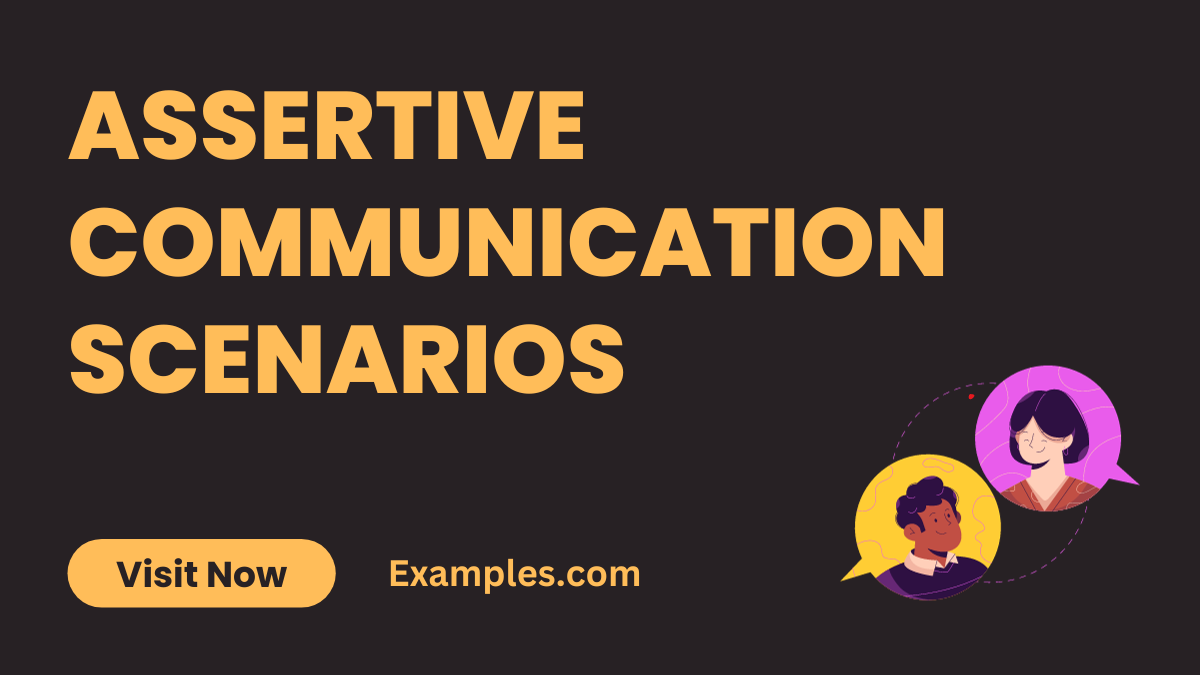9+ Assertive Communication Scenarios Examples
Assertive communication is not just a skill but a practice that can transform your interactions across various scenarios. This guide delves into practical, real-world situations, providing you with valuable communication examples and techniques. Learn how to apply assertiveness effectively in your daily life, from navigating complex workplace dynamics to enhancing personal relationships. By integrating active listening and clear expression into your communication style, you can confidently handle challenging conversations while maintaining mutual respect and understanding. This guide is your roadmap to mastering assertiveness in diverse communication scenarios.
15 Assertive Communication Scenarios

Assertive communication is crucial in diverse scenarios, from the workplace to personal relationships. This guide explores 15 scenarios where assertive communication can be effectively applied. Each scenario provides a unique opportunity to practice skills such as active listening, speaking confidently, and employing effective body language. Learn how to express yourself clearly and respectfully, adapting to different situations while maintaining your assertiveness.
- Responding to Unreasonable Work Demands:This scenario involves balancing assertiveness with professionalism. It’s about expressing your limitations and seeking a solution that respects your workload and the company’s needs.This shows assertiveness by setting boundaries while still showing willingness to find a solution.
Example:“I understand the importance of this task, but taking it on would overload my current schedule. Can we discuss prioritization?” - Handling Criticism in the Workplace:This requires active listening and an open mind. Respond assertively by seeking clarity and using the feedback for personal and professional growth.Asking for specifics shows active listening and a desire to grow, while maintaining a non-defensive stance.
Example:“I appreciate your feedback. Can you provide specific examples so I can understand better and improve? - Negotiating Deadlines with Colleagues:Assertiveness here means communicating your capabilities and limitations while striving to maintain quality and manage expectations effectively.This demonstrates assertiveness in managing workload and commitment to quality.
Example:“I’ll need more time to complete this to the best of my ability. Can we extend the deadline to ensure quality”? - Disagreeing with a Friend Respectfully:In personal relationships, assertiveness involves expressing differing opinions without diminishing the other’s viewpoint, fostering a respectful and understanding dialogue.Acknowledging the other’s viewpoint while expressing your own shows respect and open-mindedness.
Example:“I see your point, but I have a different perspective. Let’s find a common ground that works for both of us.” - Declining an Invitation Politely:This scenario is about saying no without guilt or discomfort. It’s crucial to maintain positive relations while respecting your own boundaries and commitments. This is a clear yet polite way of saying no, maintaining the relationship while respecting your own time.
Example:“Thank you for the invite, but I won’t be able to make it. Let’s plan for another time soon.” - Asking for a Raise or Promotion:Here, assertiveness is about confidently presenting your achievements and value to the organization while discussing your career advancement.Clearly stating your worth and the reasons for your request demonstrates confidence and self-awareness.
Example:“Based on my achievements and the value I’ve added, I’d like to discuss the possibility of a raise/promotion.”

- Addressing Misunderstandings Directly:Directly tackling misunderstandings prevents escalation and demonstrates commitment to clear and honest communication.Directly addressing potential conflicts shows active listening and a commitment to clear communication.
Example:“I feel there’s been a misunderstanding. Can we clarify to ensure we’re on the same page”. - Providing Constructive Feedback:This involves offering feedback that is helpful and specific, aiming to encourage improvement while respecting the receiver’s feelings.Offering specific, actionable feedback shows understanding and helps in effective communication.
Example:“Your report was well-researched, but including more data could strengthen it further - Setting Personal Boundaries in Relationships:Assertiveness in setting boundaries is key to healthy relationships. It involves communicating your needs clearly while being considerate of the other person’s needs.Assertively setting boundaries respects both your needs and those of the other person.
Example:“I value our time together, but I also need some time for myself. Let’s balance both our needs.” - Responding to Aggressive Behavior:Dealing with aggression assertively means maintaining your composure and addressing the behavior in a calm, firm manner.This approach de-escalates tension while maintaining your stance.
Example:“I’m open to discussing this, but I’d appreciate it if we could do so in a calm and respectful manner”. - Asking for Clarification in Meetings:In a professional setting, asking for clarification reflects engagement and a desire to fully understand and contribute to the discussion.Seeking clarification shows engagement and the desire for effective oral communication.
Example:“I’m not sure I fully understand your point. Could you provide more details or an example?”

- Handling Interruptions During Public Speaking:Assertiveness in public speaking involves controlling the flow of your presentation while respectfully acknowledging audience participation.Politely addressing interruptions maintains control of the situation and respects the audience.
Example:“I appreciate your eagerness, but let’s hold questions until the end so everyone can follow the presentation”. - Discussing Sensitive Topics with Family:Tackling sensitive issues requires a balance of honesty, sensitivity, and assertiveness to ensure open and effective communication.Approaching sensitive subjects with honesty and sensitivity is key in assertive communication.
Example:“This is a difficult topic, but it’s important for us to talk about it openly and honestly.” - Rejecting Unwanted Offers Firmly but Kindly:This scenario calls for clear communication that firmly declines the offer while maintaining a positive relationship with the offeror.A firm but polite rejection respects both parties and avoids ambiguity.
Example:“Thank you for the offer, but it’s not something I’m interested in at the moment”? - Requesting Support or Assistance:Here, assertiveness is about acknowledging your need for help and communicating it clearly, showing effective self-awareness and team collaboration skills.Expressing the need for help in a straightforward manner shows self-awareness and effective delegation skills.
Example:“I’m currently overwhelmed with this project. Could I get some assistance to meet the deadline”?
Assertive Communication Scenarios in the Workplace
1. Requesting a Deadline Extension:
This scenario involves clear communication and justification for the request, demonstrating active listening to project needs and a deep understanding of quality standards.
Scenario: You need more time to complete a project due to unforeseen challenges.
Example: “I would like to request an extension for the project deadline. Active listening and understanding have shown me that additional time is necessary to ensure quality results.”
2. Providing Constructive Feedback:
This example highlights the importance of providing feedback in a way that is clear and helpful, emphasizing the need for clarity in communication.
Scenario: Offering feedback to a team member to improve their performance.
Example: “Your report was very thorough, but I believe focusing more on data analysis could enhance its impact. Feedback and clarity are key here”.
3. Declining Additional Work:
This situation requires conciseness in communication and the ability to speak confidently about one’s own limits.
Scenario: You are already overwhelmed with work and need to decline additional tasks.
Example: “While I appreciate your confidence in me, I must decline additional tasks to maintain the quality of my current workload. Be concise and speak confidently about your capabilities and limits.”
4. Handling a Disagreement with a Colleague:
Demonstrating active listening and keeping an open mind helps in respectfully addressing disagreements and finding mutually beneficial solutions.
Scenario: Disagreeing with a colleague’s approach in a meeting.
Example: “I see your point, but I have a different perspective. Let’s discuss this further to find common ground. Active listening and open mind are crucial here.”
5. Leading a Team Meeting:
Effective public speaking and displaying confidence are vital for leading meetings assertively and efficiently.
Scenario: Assertively leading a team meeting to discuss project progress.
Example: “Let’s focus on our project milestones and address any challenges directly. Public speaking skills and confidence are essential in this setting.”
6. Negotiating a Salary Raise:
Assertively negotiating a salary involves clear and confident communication about your value and contributions.
Scenario: Discussing a salary raise with your manager.
Example: “Based on my contributions and market standards, I believe a salary adjustment is warranted. Clarity in communication and confidence in your value are key.”
7. Addressing Workplace Conflict:
In conflict resolution, active listening and an open mind facilitate understanding different perspectives and finding a solution.
Scenario: Mediating a conflict between two team members.
Example: “Let’s discuss this calmly and find a solution that works for everyone. Active listening and maintaining an open mind are critical in resolving conflicts.”
8. Pitching a New Idea:
When pitching new ideas, it’s important to speak clearly and with confidence, ensuring your idea is understood and considered.
Scenario: Proposing a new idea or project to your team or management.
Example: “I have a proposal that could benefit our team’s efficiency. Let me outline the key points. Speak clearly and with confidence to make your case.”
9. Responding to Unfair Criticism:
Responding to criticism assertively requires seeking clarity and viewing feedback as an opportunity for growth.
Scenario: Reacting assertively to unjust criticism in the workplace.
Example: “I appreciate your feedback, but let’s discuss specific examples so I can understand and improve. Feedback and clarity in communication are important here.”
10. Asking for Project Resources:
This scenario involves concisely and confidently communicating the needs of a project to ensure its success.
Scenario: Requesting additional resources or support for a project.
Example: “To meet our project goals, additional resources are required. Here’s what we need. Be concise and speak confidently about the project’s requirements.”
In conclusion, the practice of assertive communication is a powerful tool that enables individuals to express themselves clearly and confidently while respecting others. This guide has illustrated the importance of assertiveness in various real-world scenarios, highlighting the role of active listening and clear expression. For further exploration into this topic, consider visiting the American Psychological Association’s page on assertiveness, which provides additional insights and tips on effective assertive communication strategies. Additionally, the University of Maine offers a comprehensive resource on assertive communication, including techniques and benefits, ideal for educators and students seeking to deepen their understanding. These resources complement the knowledge gained from this guide, offering a broader perspective on mastering assertiveness in diverse communication scenarios.



